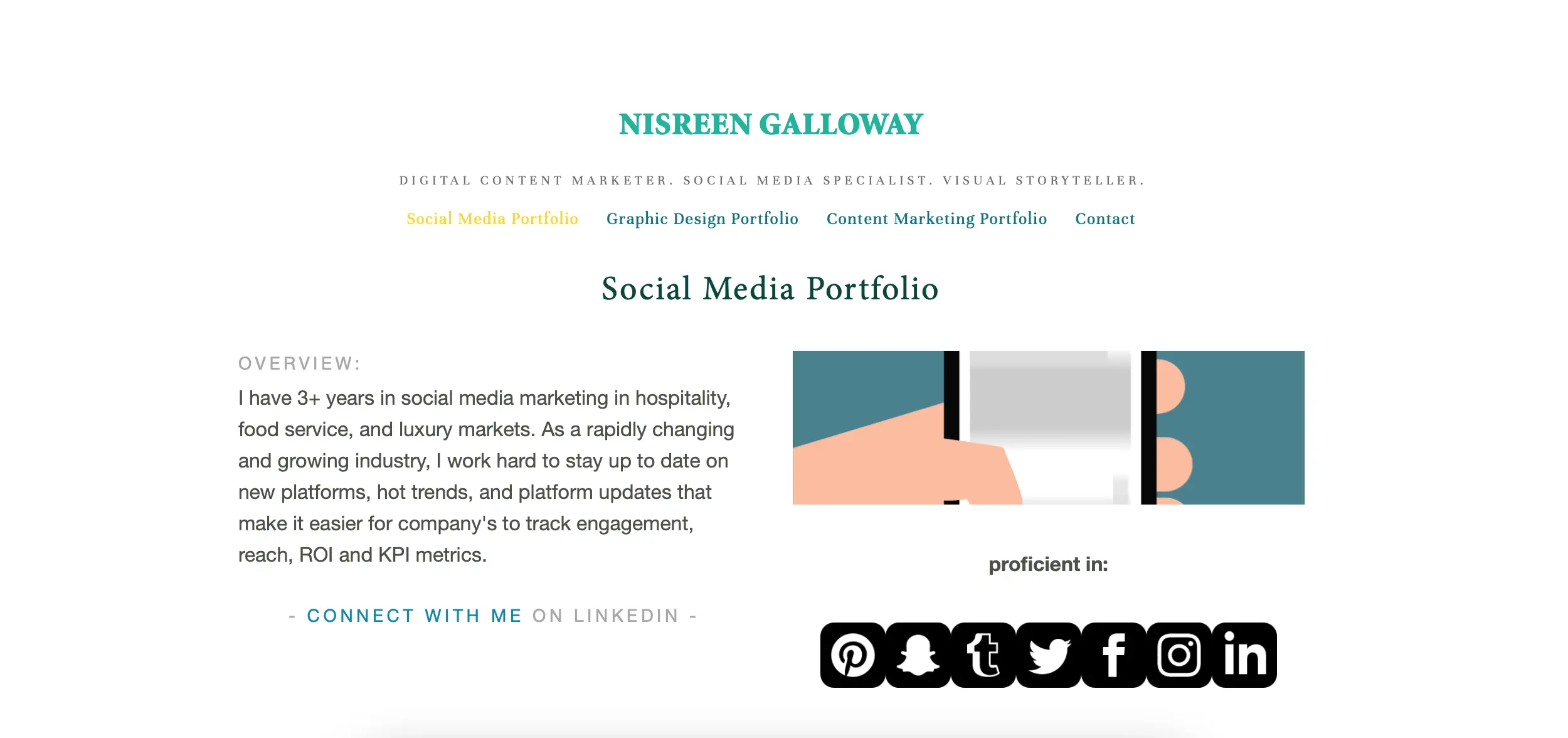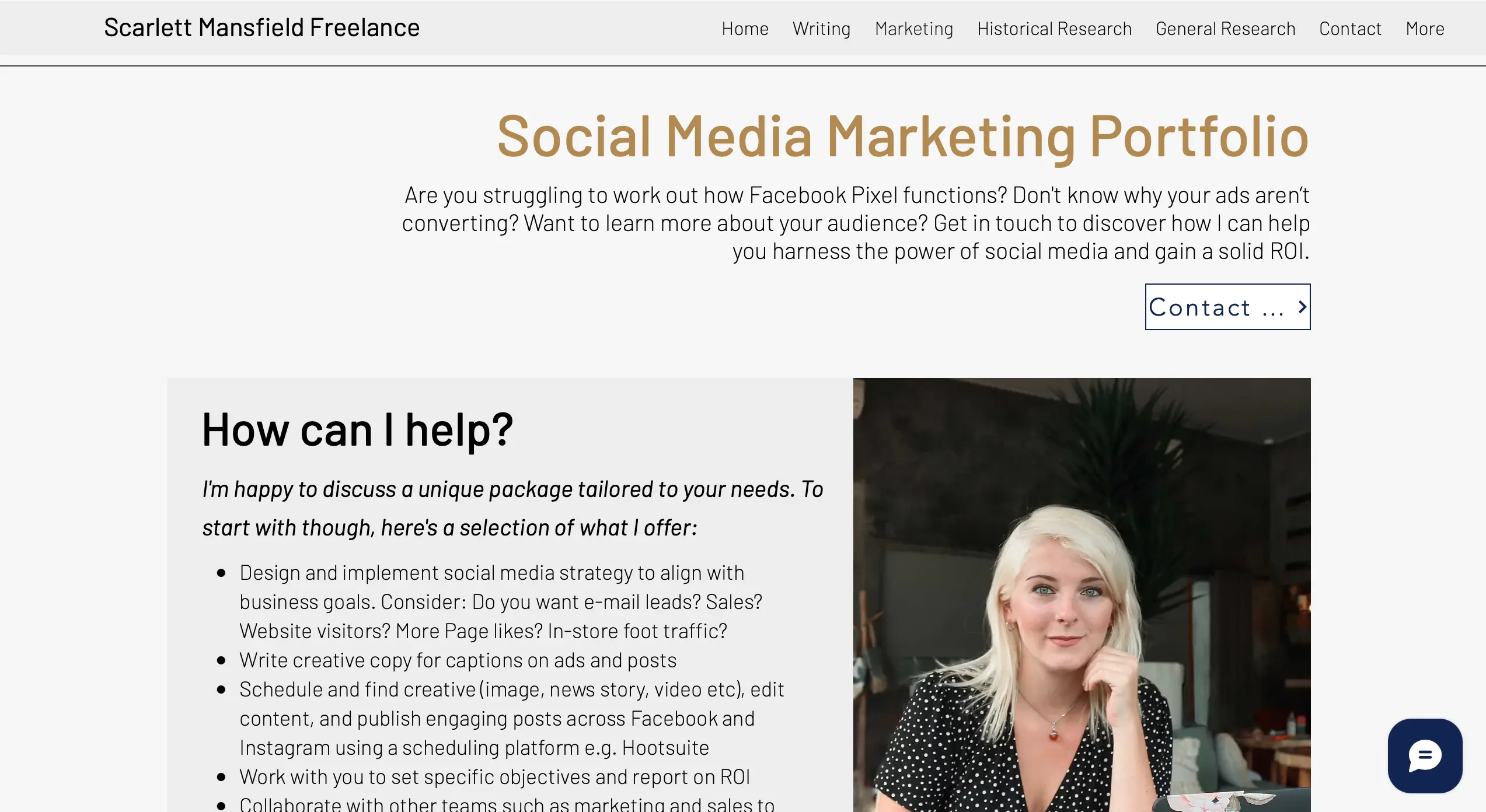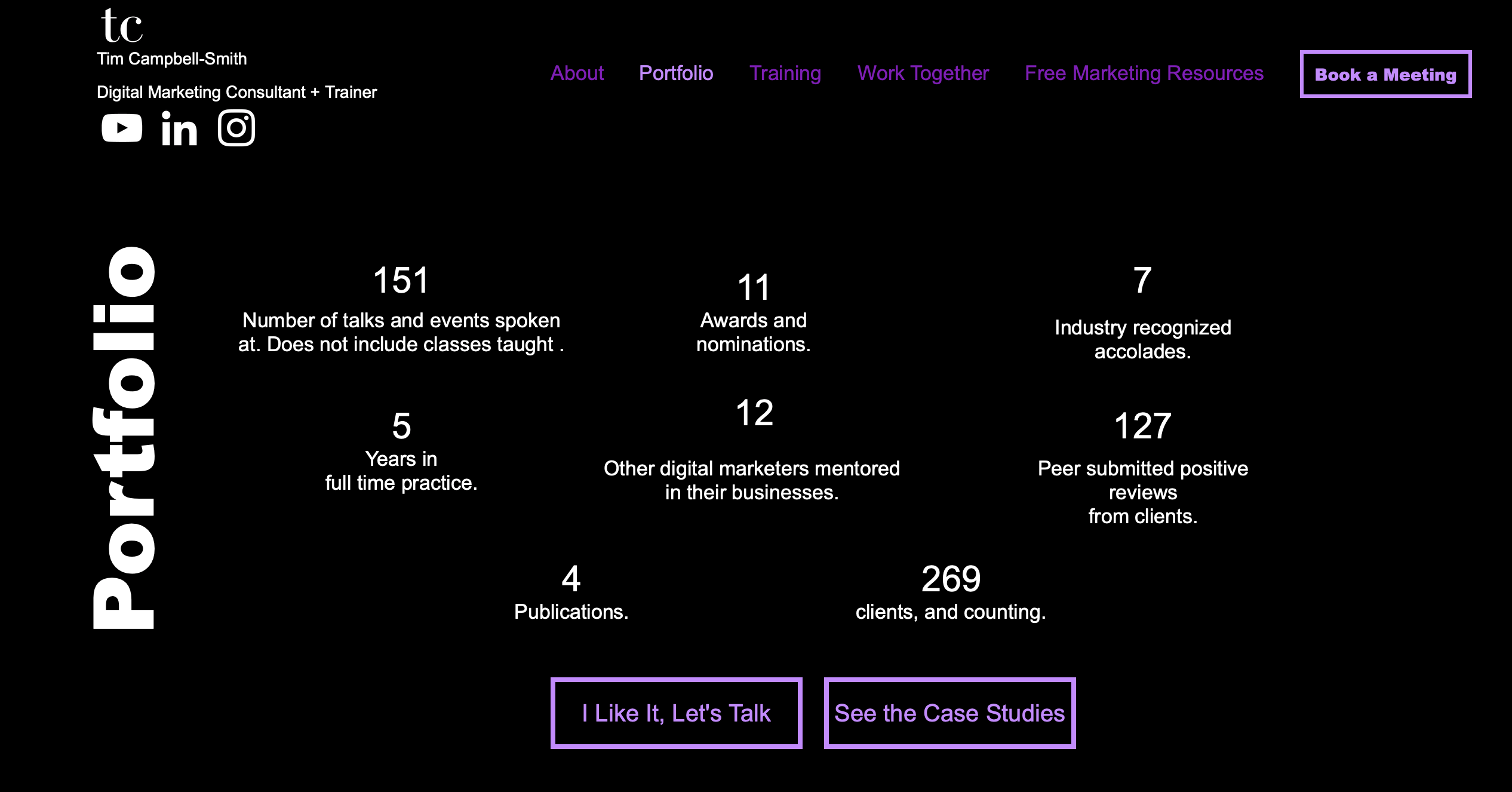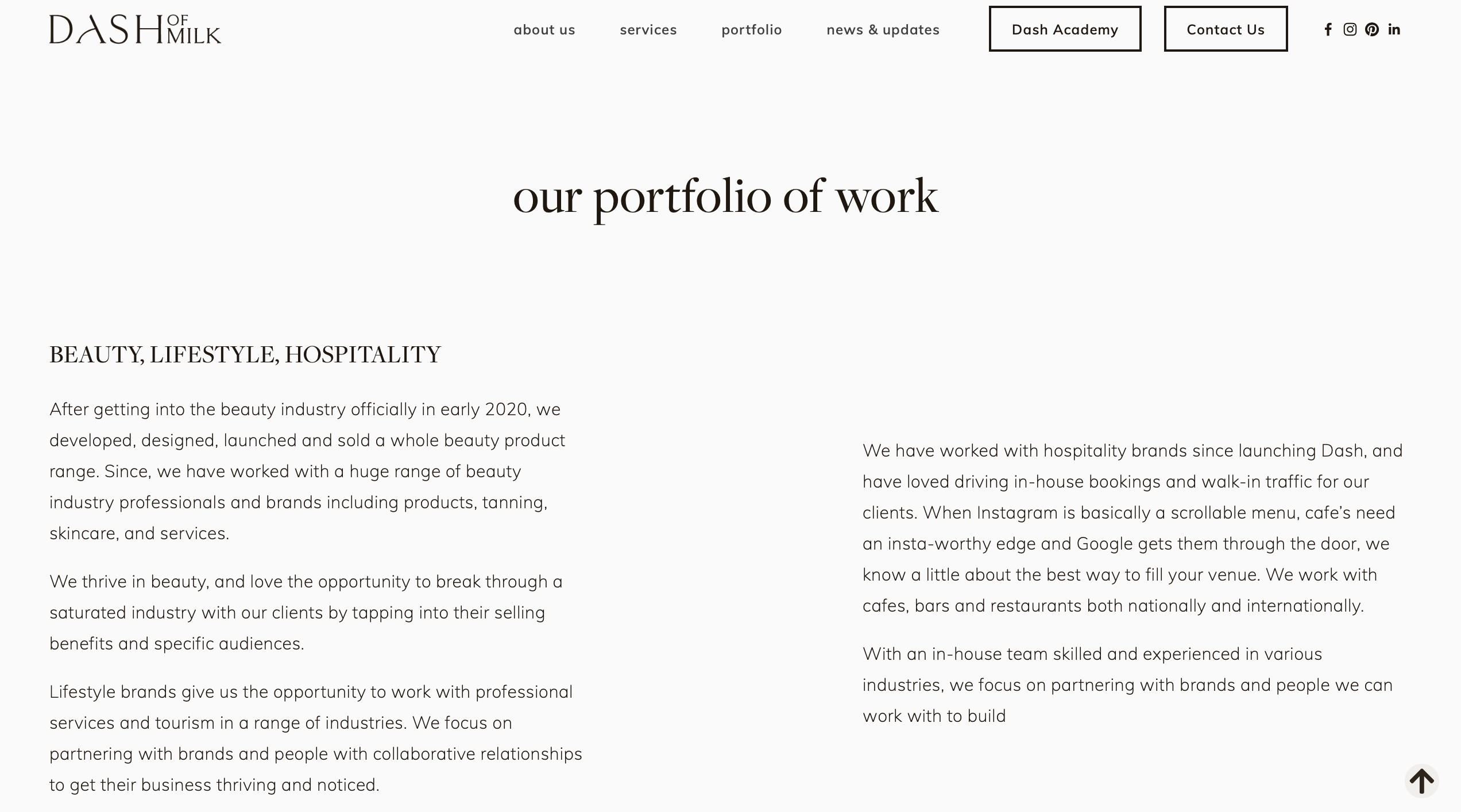With demand for social media marketers booming, you may be thinking about how you can promote your skills and services to land an impactful role in the industry.
One effective way of gaining attention and recognition as a social media marketer is through the creation of a social media portfolio. By demonstrating your experience, projects, and passions, your portfolio can be your ticket to new clients or a new and exciting social media marketing position.
But how do you create a great social media portfolio, and what do the very best social media portfolios include?
In this article, we’re going to be running you through exactly what you need to do to build a visually stunning and informationally compelling social media portfolio that you can use as part of job applications, interviews, or simply to enhance your online presence.
Here’s a clickable list of what we’ll be covering:
- Why should I make a social media portfolio?
- What should my social media portfolio include?
- The best social media portfolio examples
- Making your own social media portfolio: top tips
- Social media portfolio FAQ
- Next steps
Are you ready to learn more about crafting a winning social media portfolio? Then let’s dive in!
1. Why should I make a social media portfolio?
Although positions in social media marketing are on the rise, competition for a role in this varied, creative, and rewarding industry is still fierce. If you want to stand out from the crowd, you’ll want to be able to show why you’re the best candidate for the job by demonstrating a proven track record of compelling campaigns that have brought about the results your client or company required of you.
While a polished CV and cover letter will be able to state where you’ve worked and your passion for your career, a social media portfolio can show off exactly how you’ve achieved specific marketing goals through social media with statistics, eye-catching visuals, and short summaries of campaigns you’ve executed on.
You’ll be able to clearly demonstrate how you think, how you perform research, how you solve complex problems, the tools you’ve mastered, and your creative skills.
2. What should my social media portfolio include?
Putting together your social media portfolio is no small task and—although presentation is important—the information you display will be just as crucial. Below are some of the key elements which employers and recruiters will want to see in your social media portfolio.
Your story
Unlike a CV or a cover letter, a section which describes your route into the field and your passion for what you do can be a great introduction to your portfolio. Your story shouldn’t be too long (a paragraph is probably fine) but it should be personable and professional, while pinpointing what makes you want to do what you do. You could include this section beneath a photograph of yourself.
Your favorite campaigns
You’ll want to include some hi-res images from your most successful social media campaigns, alongside a short caption explaining the brief from the client or company, what you learned while running the campaign, and the end results.
Alongside attractive visuals of the campaign itself, you might also want to consider screenshotting and posting some of the analytics you ran alongside it, and expanding on both the outcomes you were hoping for and the outcomes which were achieved.
The following structure can be a useful way to organize the content of this section:
- Introduction to the project
- Explanation of the brief/strategy
- How the campaign was executed
- Campaign results and learnings
How you work
Providing insights into your creative process, proof of how you conduct research, documentation of competitor analysis, evidence of where you get your inspiration from, insights into user behavior analysis, and information on how you build long term strategies is all great material to include in your social media portfolio.
You could include this information on a case-by-case basis for each campaign, or provide a general overview of how you work.
Client testimonials
Testimonials from previous clients or employers are an important addition to your portfolio. These positive accolades can be screenshotted from direct messages or emails you might have received from happy customers, or you can request them specifically from clients you’ve worked with explaining you’d like to use them in your portfolio.
A list of your services, skills, and favorite tools
A social media portfolio is a neat opportunity to list all of the services you offer if you’re freelance or that you’d be capable of performing if hoping to join an in-house team.
Consider also adding a short list of skills and your favorite tools too, to demonstrate your aptitude in the field and what you’re happy to be contacted about.
Some social media marketing services you might want to include on your portfolio could be:
- Social media trends
- Content creation (copywriting, graphic design, etc)
- Community growth and management
- Content strategy
- Branding
- Content publishing & scheduling
- Competitor analysis
- User research
- Influencer relationship building and marketing
Skills in social media marketing which employers will be looking for on your portfolio include:
- An awareness of trends
- Great time management and planning
- A love of community, conversation, and customer service
- A passion for storytelling
- An eye for design
- A talent for understanding statistics and analytics
- A deep knowledge of social media platforms
- Desire to learn new tools and processes
- A knack for building strong relationships
The tools you include on your social media portfolio will vary depending on where your expertise lie, but some key social media marketing tools you might wish to include are:
3. The seven best social media portfolio examples
To give you some inspiration for your own social media portfolio, we’ve collected together some of our favorites. Take a look at these creative and engaging pages from digital content managers, freelance marketers, social media strategists, and community managers to get some ideas for your own portfolio.
1. Nisreen Galloway: Digital Content Manager & Social Media Specialist

- Nisreen’s portfolio ticks all the boxes. It has their story as the intro to the page, accompanied by a compelling visual, with details of how to contact them on a range of different social media platforms available directly beneath.
- They describe three important use cases they have worked on, outlining the goal of each project, the results of their work, and displaying an engaging visual consisting of the different images used in the project.
- Finally, Nisreen provides an easy-to-read bulleted list of the main actions they performed during the campaign, for example, creating viral posts under community hashtags, and working with video content producers to increase the quality of posts.
2. Scarlett Mansfield: Freelance Writer & Marketer

- Scarlett’s portfolio cleverly begins by asking potential clients and users about their social media marketing pain points: “Don’t know why your ads aren’t converting?”. In doing so, she is demonstrating her understanding of her users’ problems and that they are in the right place to find a solution.
- The bulleted list in the ‘How can I help?’ section runs through the services she offers, allowing visitors to her site to easily see how she might work with them and improve their social media marketing.
- She explains the difference between Organic and Paid growth in marketing as well as what her preferred approach is. This is a clever way to educate her clients and appear in results for SEO queries about organic and paid marketing techniques, in doing so reaching more potential clients.
- She finishes her social media portfolio with two different case studies. Beneath she provides detailed statistics proving the success of her work on the campaigns in addition to the activities she undertook to achieve these impressive results.
3. Julia Babicheva: Social Media Marketing Professional

- Julia begins her profile with a short introduction outlining her experience and the industries she’s worked in, accompanied by a picture of herself.
- She follows this with a more detailed overview of her experience, the types of strategies she’s implemented, and the platforms she’s familiar with.
- The following pages focus on use cases. She describes the client, the brief, the goals of the project, and the results that her work brought about. She intersperses this information with useful graphs and statistics which support each use case.
- In her final two pages, she writes a list of her expertise and provides her contact information.
4. Tim Campbell-Smith: Digital Marketing Consultant and Trainer

- Tim Campbell has created an entire website for his digital marketing consulting and training, with a page dedicated to his professional portfolio. While potential clients can check out the site’s About, Training, Work Together, and Free Marketing Resources pages for more information about Tim and his work, his portfolio page concentrates on his professional achievements, the professional organizations he is a member of, awards and nominations he has received, and statistics covering what he has accomplished in his career since he started out.
- Tim has created a sub-page for his portfolio specifically to talk about case studies and clients. On this page he lists the companies he’s worked with–with accompanying photographs-and provides a short outline about the work he completed for them.
- Tim ensures that on every single page of his website, including the portfolio page, his contact information (email, phone number, and social media handles) is clearly visible, ensuring clients can always reach him with ease.
5. Dash of Milk: Social Media Agency

- Although Dash of Milk is a social media agency rather than an individual, their portfolio page is a great example of how to present your work in an eye-catching, stylish, and informative fashion to win over new clients or promote your skills and experience to potential employers.
- The portfolio page of Dash of Milk’s website begins with a compelling story about the history of the agency, its passions, and the range of industries with which the team has the most experience.
- When the user scrolls down, they come across the three main industries Dash of Milk works with: beauty, hospitality, and lifestyle. Using a clickable picture for each theme, users can click through to a page dedicated to Dash of Milk’s use cases and clients from that particular industry. The use cases outline the client’s original problem or goal and how Dash of Milk worked with the company to create a solution. On this page, users will also find glowing testimonials from the aforementioned companies, as well as the services Dash of Milk offers, eg: Paid Campaigns and Branding & Graphics.
- Back on the main portfolio page, shorter snippets of use cases sit alongside client testimonials and the company’s contact details.
6. Vikki Gois: Creative Director & Social Media Strategist

- Vikki Gois’ visually engaging social media portfolio website is the perfect demonstration of her wide range of skills and services through the presentation of projects and use cases. The first thing visitors to the website see is a collection of short introductions to the campaigns she has written scripts for, each with a stunning image which users can click on to access further project details.
- On each individual campaign page, Vikki provides a video from the campaign (where applicable) in addition to a full description of the project, the professionals she worked with, and the results of her input and services.
- Beneath the script writing section, users find a reel of some of Vikki’s other projects, from copywriting and content creation, to creative direction and offline store displays.
- Finally, Vikki winds up her portfolio page with another compelling collection of visuals from her writing for online and print publications, again with click-through links for more details.
- Additional pages of her portfolio site address who she is, her background, education, contact details, and qualifications, while her social media handles are available on every page of the site giving potential clients easy access to more information about her work.
7. Molly O’Toole: Community & Media Manager

- Molly O Toole’s portfolio site is simple and stylish. The short intro, accompanied by a photograph, describes both what drives her and her key skills, giving potential recruiters or clients an immediate insight into what she can offer.
- She follows her intro with a collection of four use cases with large clickable images. When a user clicks on an image, they are taken to the project page which provides more details of the project and a range of images from the campaign Molly directed.
- In addition to the main portfolio page, Molly provides more details about herself in a My Story section, in doing so, adding a more human touch to her page. To make it easy for potential clients or recruiters to contact her, she also has a dedicated Contact Me page with a simple form for getting in touch.
- Molly’s social media portfolio is a great example of “less is more”. Rather than overwhelming the reader with every campaign she’s ever worked on, she has instead focused on some key projects that effectively demonstrate her range of skills and services. In terms of information about herself, she keeps it simple and to the point, demonstrating once again that a portfolio site need not cram in every detail of a professional’s career, just the highlights.
4. Making your own social media portfolio: top tips
1. Check your NDAs!
Marketers are often required to sign non-disclosure agreements (NDAs) which can restrict which work can be used for public portfolios.
Before putting all the work into a portfolio, check the contracts you’ve signed with former employers or clients regarding which work you’re allowed to use. If there’s something you’re particularly keen to include, but you’re restricted by an NDA to use publicly, you can always reach out and ask politely if an exception can be made.
2. Only include relevant work
If you’re using your portfolio to apply for social media marketing positions or freelance work, be sure to include only relevant projects in your portfolio.
Recruiters will be able to see your previous positions on your CV, but it can be confusing if you start throwing in roles or jobs you’ve done that don’t directly prove your expertise in the field on your social media portfolio.
If you’re just starting out and don’t have many social media marketing projects to include, don’t be afraid to include personal projects or tasks you’ve completed for friends or family to demonstrate your passion and commitment to this career.
3. Keep it simple and use plenty of visuals
Your social media portfolio shouldn’t be too text heavy. Recruiters will want to see brief explanations of a project brief or goal and key statistics or results alongside some stunning visuals from the campaign itself.
Too much text can be off-putting and you can always link out to further resources or information that take the user off the page itself. Additionally, potential clients can always ask for more details in an interview setting or via email if they need to know more about exactly what services you performed.
4. Focus on results
If you’ve had some fantastic results from a campaign or project, your portfolio is the place to shout about them. Remember, your portfolio is like a proof of concept for a recruiter, potential client, or employer. Consider including the following metrics for a project, where possible:
- Increase in followers
- Increase in engagement
- Increase in clicks
- Increase in website traffic
- Increase in sales
- Increase in returning customers
- Increase in recommendations
5. Don’t forget your own social profiles!
It’s important to keep your own social media presence engaging and up-to-date when promoting your portfolio, as it’ll be the first place employers and recruiters are likely to look once they’ve checked out your campaigns.
You don’t need to have millions of followers, but you should be able to demonstrate your ability to create engaging posts and stories that excite and intrigue your followers.
5. Social media portfolio FAQ
What should be included in a social media manager portfolio?
A social media manager portfolio should showcase a range of social media campaigns you have managed, highlighting the goals, strategies, and results achieved. It should also include examples of social media content you have created, demonstrating your creativity and attention to detail. Additionally, it’s beneficial to include any relevant certifications, training, or achievements in the field of social media marketing.
How do I create a social media marketing portfolio?
To create a social media marketing portfolio, start by selecting 5-10 of your best social media campaigns that demonstrate your skills and achievements. Include a brief overview of the campaign goals, target audience, and strategies used to achieve the desired results. Additionally, showcase examples of the social media content you created, including graphics, videos, and written copy. Finally, highlight any notable metrics, such as engagement rates, conversions, or ROI, that demonstrate the success of your campaigns.
6. Next steps
If you’re ready to start making steps towards a career in social media, then using this guide to create a social media portfolio is a great place to start.
However, if you’re not quite ready to start building your portfolio, or you’re struggling to think of projects to include, then here’s a few simple steps you can take right now to boost your skills and experience.
- Get some experience in social media: Consider applying for an internship or by building your own social media campaigns, measuring the results, and recording your learnings.
- Train up: Whether via an online course, a full-blown degree, or an in-person bootcamp, freshen up your skills and learn new ones related to process, strategy, analytics, and the latest social media tools.
- Meet social media professionals: Attending industry events and meetups (both online and in-person) is a sure fire way for you to learn more about this career, build your professional network, and learn about new job opportunities.
- Start your job search: If you’re looking to use your portfolio to find a permanent position, check out job sites such as LinkedIn, Glassdoor, Indeed, and Monster to find suitable junior positions. You can also set up Google Job Alerts with search terms related to social media marketing, and send prospective application letters to companies that you would particularly love to work for. Don’t know what to look for? We’ve got a list of the best social media jobs in this article.
- Offer your services: While you’re still building your experience (and your portfolio) offer your services to smaller companies on a freelance basis to learn as much as you can. These opportunities will also provide you with useful use cases you can talk about with future employers.
Interested in learning more about how to forge a career in social media, or digital marketing in general? Why not try out our free, 5-day digital marketing short course? You may also be interested in the following articles:
